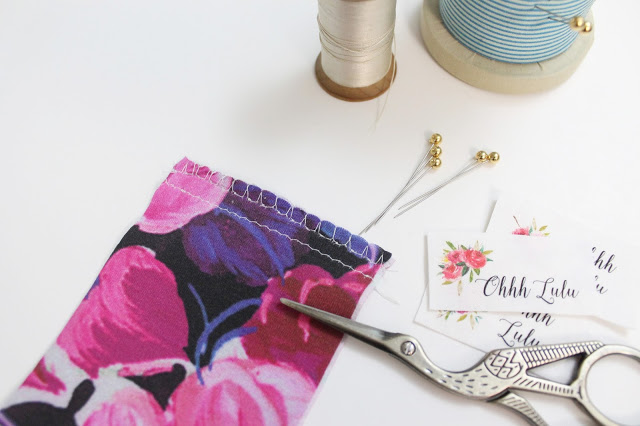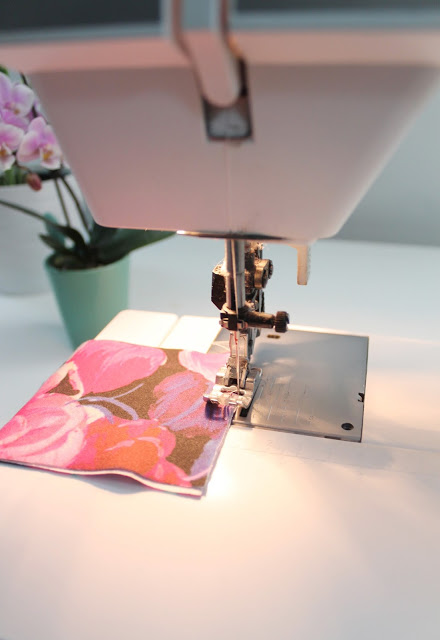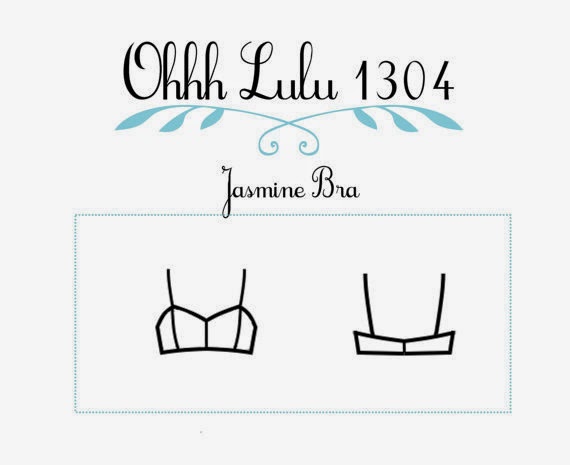Stitch right to the edge of the fold and lower your needle into the elastic. Raise the foot and pivot your garment so that the you can now zig-zag stitch over your folded edge, creating a nicely finished join. Backtack at the end of your stitching.
Stitch right to the edge of the fold and lower your needle into the elastic. Raise the foot and pivot your garment so that the you can now zig-zag stitch over your folded edge, creating a nicely finished join. Backtack at the end of your stitching.
 |
| Zig-zag stitched seam with faux-overlocked edge |
 |
| Using the Overlock Stitch to finish raw edges. |
The last stitch I wanted to mention is the Stretch Stitch (or at least that’s what I call it). It creates a very stretchy seam, but on my machine, is pretty slow going because of the complexity of the stitch. When I’ve used this stitch in the past, I’ve simply trimmed my seam allowance right back without any extra seam finish.
If you are new to sewing knits, spend some time getting to know the different stitches on your machine. There are so many options for sewing stretch seams and finishing edges without having to use a serger. These are just a few options, and I hope you find them useful!
What you need:
1. Any triangle front bra pattern, like my Josephine, Scarlett (which I have used here), or Brigitte Pattern.
2. Supplies as outlined in the pattern.
3. G-hook or Front Clip
Instructions:
1. Following the pattern instructions, assemble cups and apply elastic around front edge.
2. Beginning at the center front and leaving a 1″ tail, apply the band elastic along the lower edge of the bra. Leave a 1″ tail and the end.
3. Feed one end of the elastic “tail” through the closed end of the G-Hook. Turn elastic towards garment and stitch in place.
 |
| Your hook should be upside down at this stage! It will get flipped around soon. |
That’s it! now you have a neatly applied front hook closure! Enjoy!
What You’ll Need:
1. The Emma Romper Pattern
2. A fabric with a good drape. I’m using a Liberty of London silk.
3. Lace trim for the neck and legs.
4. Sew in or Hammer in Snaps
5. Small Scrap of Interfacing
6. 1/2″ Strapping and bra strap rings & sliders
7. Needles and Thread
Instructions:
1. Begin by applying lace along Front Neckline, as indicated in the Pattern Instructions.
2. With the wrong sides together, pin your center front seam. Stitch together using only a 1/4″ Seam allowance.
5. Stitch seam closed using a narrow, 1/4″ seam allowance.
7. Sew lace onto the right side of the garment. Turn seam allowance under and press. Top stitch in place. An extra pretty way to finish the leg openings would be with appliqued lace. Check out my hero, Carine Gilson for some dreamy inspration.
8. In this intance, I’ve finished the raw edge of the crotch seam with self fabric. I measured the width of the crotch seam (including the lace portion) and added 1/2″ to either side. I wound up with a measurement of 5″. I cut 2 pieces of fabric and 2 pieces of light weight interfacing that were 5×2″
9. Iron interfacing onto the wrong side of your fabric strips. Fold in half lengthwise and press.
10. Pin and stitch on to the right side of the Front of the Romper.
12 Turn strip towards the inside of the garment, and top stitch all the way around the exterior of the strip. Repeat this process on the opposite side.
2. Cut your fabric – I’m lining the entire thing.
5. Sew your side Seams and try them on. They should fit snug all over.
6. Sew the waistband into a continuous loop. Fold in half and press with a light iron. Attach to the waist of the panties, lining up your side seams.
7. I top stitched down my waistband seam allowance using a twin needle.
That’s it! I’ve found it takes some getting used to sewing swim fabrics. They are slippery and can be hard to manage. But, the more bathingsuits I make, the better they get!
Here I am in mine. Neverind the pug butt and falling down fence. I made Izzy a matching suit too! Now hopefully the weather gets a little warmer so I can test mine out at the beach.
What you’ll need:
1. The Sarah Bralette Pattern and Ava Panties Pattern
2. Coordinating Swimsuit (Spandex) fabric.
3. Swimsuit Lining
4. Thread
5. Twin Needle
6. Rotary Cutter (optional, but handy)
Instructions:
1. Print out your patterns.
2. Trim away margins where indicated.
3. Tape pattern together.
4. Optional: I wanted to have a diamond motif pattern layout on the back, so I added seam allowance to both my back pieces, instead of cutting them on the fold.
5. Make adjustments. I have a slightly larger cup size than what I’ve drafted this pattern for. All I have done is cut between a size small and medium. If you need a significant change to the bust area, you can slash and spread the cups to increase the size. You can also wing it, like I sometimes do, by just exaggerating the curve of the cup and adding some height. If you are more petite, just straighten that sucker out. Check out my tutorial on adjusting the cup size of my Jasmine Bra for some further instruction.
 |
| Cutting between a small and medium |
5. Optional Pattern Placement: I have drawn a line on my pattern pieces so I know where to place my stripes. I wanted to create a chevron motif over the bust so I took a little bit of time before cutting my fabric to make pattern placement indicators on my pattern pieces.
12. Baste Binding along front edge of cup using a narrow zig-zag stitch. Gently pull on the binding as you stitch. You wan the suit to contour along your bustline. When you’re done, turn the binding under and top stitch with a twin needle. If you don’t have a twin needle, you can also zig-zag stitch. The binding gets applied exactly the way you’d apply any binding (though I apply mine to the right-side first). I made a Video! Watch!
 |
| Raw edge trimmed back, binding is ready to be turned under and top stitched. |
 |
| Twin-stitched binding. |
13. Baste Lining to Center Front Band.
15. Stitch cups to Front Band
19. Now it’s time to bind the upper edge of our tops. I used a length of binding approximately 80″ long (I had to attach two pieces in order to get this length). I started basting on my binding approximately 31″ down the length of the binding – this extension forms your strap. You will be left with a long extension on the opposite end as well.
21. Cut your straps so that they are both an even length and tie the ends into knots.
I’ll post the tutorial for the coordinating bottoms in a separate post!
 |
If you are a D-DD Cup (or larger!), you will want to exaggerate the curve of the cup as well as increase the height to provide better coverage. Here, in purple ink, I’ve increased the bust curve by 1/2″ on each pattern piece at the apex. I’ve also extended the top of the cup by 1/2″.
Because this pattern is to be sewn in stretch knits, the fit is really quite flexible. If you are above a DD (this includes myself!), you may find that this simple adjustment, adding 1″ to the bust apex + a bit of height, will be all you need to get a better fit. Remember, it is really important when sewing any garment, but especially lingerie, that you sew a mock up first in a fabric of a similar weight and stretch. This way, you can make any pattern adjustments to get a truly custom fit!
Voila! Two easy ways to finish off your garments… And you’re done!
Using your markings as a guide, punch small holes where your eyelets will go. You can use an awl, or grommet pliers to make your hole.
Eyelets can be applied a number of ways – there are two common tools pictured above.
1. Grommet Pliers – these can be found at most hardware store, and will set 2 piece grommets. Grommets come in many different sizes, so make sure the pliers you buy fit the eyelets you want to set.
2. Tool & Die – These often come with eyelet packages you purchase at the fabric store, and are set with a hammer.
I used grommet pliers to apply my grommets, and used a 2 piece grommet. Two piece grommets are preferable for a corset that is going to be worn for an extended period of time, or if you plan on wearing it a lot. Eyelets without washers tend to have rough edges and will work their way through your fabric, if you are applying much strain to the fabric around it.
Remember to insert a bone on either side of your eyelets to keep your lacing laying flat. This is the only spot in your corset where I really, really advise that you use boning. The rest is up to you!
Now, lace it up and see how it fits! Do you feel like you need to add more boning? Does everything lay flat?
Next we are onto our binding.